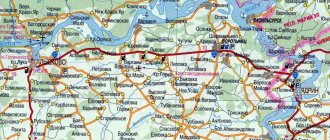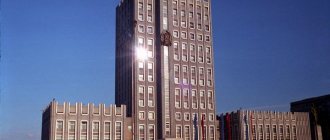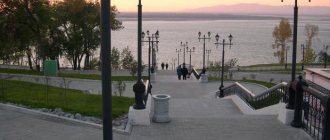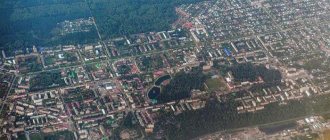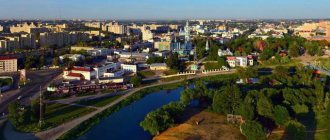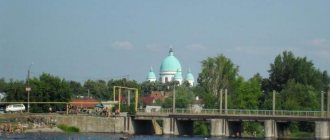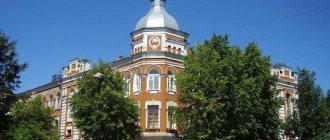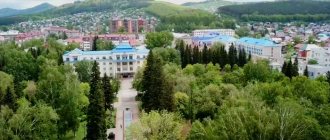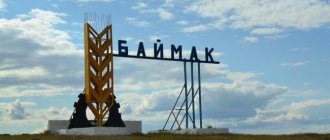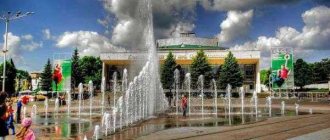Blagoveshchensk is one of the major centers of the Far East. This city is the only administrative center in Russia that is located on the border with another state, in particular on the banks of the Amur River. Located 7985 km east of Moscow. On one side of the river is Blagoveshchensk, and on the other is the Chinese city of Heihe. The state border of the Russian Federation runs along the river bed. The satellite map of Blagoveshchensk does not divide the territory of the earth's surface into boundaries and borders, so both look like a single whole.
History of the creation of the settlement and its development
Blagoveshchensk today is an average city, which is not much different from other settlements. However, the history of its creation and ennoblement has a lot of interesting facts. The city is believed to have been founded in 1856. At first it was just a military post, which was inhabited by only a few detachments of settlers. After 12 years, the population of Blagoveshchensk amounted to more than 3 thousand inhabitants. In 1888, this figure increased to 20 thousand. It is worth noting that the rapid population growth was not accidental. Blagoveshchensk attracted large numbers of migrants with its huge mineral reserves. Surprisingly, in just one year, 1894, more than 10 tons of gold were extracted from the bowels of the earth in the city of the Amur Region.
Already at the beginning of the 19th century, Blagoveshchensk became a merchant settlement. It is worth noting that the soil in the city, which borders China, was unusually fertile at that time. It is for this reason that each resident of the region received about 800 kilograms of grain per year. During Soviet times, the settlement was closed. It was possible to get there only by invitation of close relatives.
Today the city of Blagoveshchensk is distinguished by its close connection with the Chinese Heihe. Residents of the locality can visit it without a visa.
Blagoveshchensk
(Amur region)
OKATO code:
10401
Founded:
1856
City since:
1858 City of regional subordination
Center:
Amur region
Center:
Blagoveshchensk district
The city was formerly called:
| Ust-Zeya military post | 1856 | 1858 |
| Telephone code (reference phone) | |
| 4162****** | (416) 990-91-11 |
Deviation from Moscow time, hours:
6
Geographical latitude:
50°17′
Geographical longitude:
127°32′
Altitude above sea level, meters:
130 Sunrise and sunset times of the Sun and Moon in the city of Blagoveshchensk
Weather in winter and spring seasons
Migrants often pay attention not only to the economic situation of the city, but also to its weather conditions. This is an important point when choosing a place to live. The weather in Blagoveshchensk in winter is dry. It is for this reason that snow rarely falls in the populated area. Low air temperatures prevail for five months, starting in October. Despite this, winter in Blagoveshchensk is characterized by sunny and clear weather. Surprisingly, the average air temperature in this locality in winter is -20 degrees Celsius, and the minimum is -45.
The weather in Blagoveshchensk in spring is quite cool. The average air temperature in March is -7 degrees Celsius. Surprisingly, in April in Blagoveshchensk there can be not only ice, but also a snowstorm.
Blagoveshchensk in summer and autumn season
The population of Blagoveshchensk notes that the city is hot in the summer. Typically, the minimum air temperature during this period is 25 degrees Celsius. July in this locality is considered not only the hottest month, but also the rainiest. It is at this time that floods often occur. The last one was registered three years ago.
The average air temperature in Blagoveshchensk in autumn is 5 degrees Celsius. The season lasts about 40 days.
Coat of arms
The coat of arms of Blagoveshchensk is presented in the form of a green French shield. In the middle part there is a silver wave-like belt. Above it, at the top, are three octagonal gold stars. They are located in one row.
The coat of arms is topped with a turret in the form of a three-pronged crown, symbolizing military historical significance. The composition is surrounded by golden ears of corn, embodying growth and rapid development. They are connected by a red Alexander ribbon.
Heraldry was adopted by City Duma Decision No. 114 of December 25, 1997.
Time difference with Moscow
It is worth noting that Blagoveshchensk is not only different in weather. Time in this locality also has several features. It is no secret that the time may differ noticeably in different cities of the Russian Federation. If you are planning to migrate to Blagoveshchensk, then you need to study in advance the peculiarities of the time zone to which this locality belongs.
The distance between Moscow and Blagoveshchensk is more than 5 thousand kilometers. It is for this reason that the time difference in these cities is 6 hours. For example, when it is two o’clock in the afternoon in Moscow, it is eight o’clock in the evening in Blagoveshchensk.
One of the cities in the Far East of the Russian Federation is Blagoveshchensk. Time in different localities, as we said earlier, may differ. The time difference between Blagoveshchensk and Heihe is only one hour.
Blagoveshchensk - what region or region, attractions of Blagoveshchensk
The city has many attractions that are sure to impress visitors. Tourists come to Blagoveshchensk throughout the year, but the optimal season is spring and summer. Where to go in Blagoveshchensk:
- Amur embankment. The settlement is the only one located on the border of states. In order to see Heihe, you don’t even have to take binoculars. Just come to the embankment and look at the opposite bank of the Amur. By the way, there are a number of special rules for visiting China for residents of border settlements. The length of the embankment is more than seven kilometers. This is a cozy, modern street with special fences and excellent locations for taking pictures.
- Dinosaur Graveyard. The attraction is a real natural monument located in the southeast, away from the center. A local bus or taxi will help you get there. Excavations are constantly taking place in the Amur region, including in the regional center. Scientists are constantly discovering new dinosaur parts. In 1911, many bones of an ancient animal were recovered from the ground, from which a full-length dinosaur figure was reconstructed. She was sent to the St. Petersburg Institute of Geology.
- Church of the Annunciation of the Blessed Virgin Mary. The date of construction of the temple is 2002. Before that, on the site of the church there was the oldest city cathedral, which burned down in the twenties. The modern church with seven gilded domes, a thirty-two meter high bell tower and luxurious frescoes is a favorite tourist attraction. Inside you can get acquainted with the miraculous icon, which, according to legend, has been in the Amur region since the seventeenth century.
- Puppet Theatre. In the Far East, the oldest puppet theater is located in Blagoveshchensk. His performances were attended by more than one generation of townspeople. The founding date of the famous theater is 1964. The first director is Semyon Bogorod. There are wonderful performances here that will appeal to both adults and children. The ticket will not be expensive, but every ruble will pay off in seas of positive emotions.
Location of Blagoveshchensk
It is no secret that the location of a city plays a big role in its economic situation. Migrants also often pay attention to this factor. Blagoveshchensk is located quite well on the map. The city is located in the Far East of the Russian Federation. The settlement is surrounded by two rivers - Amur and Zeya. Surprisingly, the layout of the city blocks of Blagoveshchensk has not changed since its founding.
Blagoveshchensk is easy to find on the world map. It borders Heihe, Khabarovsk and Transbaikal Territories, Yakutia and the Jewish Autonomous Region.
Geophysical characteristics
If we consider the location of Blagoveshchensk, it should be noted that it is located on the southwestern side of the Zeya-Bureya Plain, at the junction of the confluence of the Zeya River and the majestic Amur.
Local small rivers flow through the entire city: Chigirinka and Burkhanovka. The landscape is flat, with some hills only on the outskirts.
The map shows that between the Chinese city of Heihe and the administrative center of the Amur region, the distance is no more than 800 meters. This fact made it possible to sign a bilateral agreement on a visa-free regime for residents of both cities.
Population
Since the founding of the city, the population has increased annually. The situation changed dramatically after the collapse of the USSR. In 1991, the population was 211 thousand citizens. Four years later, this figure increased by only two thousand. Many migrants are attracted to Blagoveshchensk. The population today is about 224 thousand. Having analyzed all the available information, we can conclude that the growth of residents has slowed down significantly.
Cost of goods and services in Blagoveshchensk
It is no secret that the cost of real estate, products and services plays a large role in the economic situation of a city. Few people know, but over the current year, prices in Blagoveshchensk for buying a house have decreased by 39%, and the cost of secondary apartments has increased by 8%. In the near future, it is planned to create a unique monitoring system in Blagoveshchensk. Thanks to it, city residents will be able to compare prices for food and medicines in different supermarkets and small stores without leaving their homes. It is worth noting that the population of Blagoveshchensk expresses their dissatisfaction with the fairly high prices for baby food, meat, sugar, fruits, cereals and sausages. City residents also emphasize that prices for the same product often differ greatly in different stores.
Employment in Blagoveshchensk
It is no secret that many people, when moving or choosing a future profession, take into account the list of the most popular specialties in a particular city. Builders have the best paid jobs in Blagoveshchensk. The most common jobs required are masons, concrete workers, carpenters and plasterers. The average salary of builders is 20 thousand rubles.
Vacancies and work in Blagoveshchensk are quite monotonous. As a rule, in this city, office workers and technical workers are primarily in demand. The second place in popularity is occupied by the hotel and restaurant business. Every day, cafes and hotels in the city need waiters, cooks and maids. The average salary of such workers is 15 thousand rubles.
Blagoveshchensk cultural
An inquisitive tourist will not be tormented by the problem of where to go in Blagoveshchensk in order to fill his leisure time with vivid impressions and learn something interesting. The doors of the city's museums and theaters are always open to guests.
Museum of Local Lore named after. G. Novikov-Daursky
- Opening hours: daily, except Monday, from 10:00 to 18:30, on Thursday from 10:00 to 20:30.
- Ticket price: adult 300 rubles, student 100 rubles, children under 16 years old are admitted free.
- Phone: +7 416 252‑36-26.
- Website: https://www.museumamur.org
- Address: st. Lenina, 165. Transport stop "DORA".
One of the oldest Far Eastern museums is located in a historical mansion built in the 19th century, which housed a German store before the revolution. Here, in 26 halls, unique exhibits telling about the history of the region are displayed. The extensive collection of the institution contains more than 155 thousand items. Exhibits of fossils, some of which are over 65 million years old, are always popular with visitors. Among the pearls of the exhibition are samurai armor dating back to the 18th century. and a meteorite that fell at the beginning of the last century in the vicinity of Ust-Nyukzhinsk.
Museum of Paleontology
- Opening hours: weekdays from 8:00 to 17:00.
- Ticket price: adult 200 rub., child 100 rub.
- Phone: +7 416 252‑34-54.
- Website: https://www.pm.amurnc.ru
- Address: Ryolochny Lane, 4. Transport stop “School No. 1”.
It is definitely worth visiting the collection of the unique museum, founded in 1997. Visiting here will be equally interesting for both children and adults. Visitors will be treated to a fascinating journey into the amazing world of prehistoric giants. One part of the exhibition is dedicated to dinosaurs that inhabited the lands of the Amur region during the Cretaceous period, the other to mammoths and other representatives of the ancient fauna. In addition to various fossils, here you can see reconstructions of lizard skeletons and listen to a wonderful lecture about their habits.
Amur Drama Theater
- Opening hours: performances are given from Thursday to Sunday inclusive. Performances start on weekdays at 18:30, on weekends at 18:00, Sunday performances for children at 12:00.
- Ticket price: from 200 rub. up to 600 rub.
- Phone: +7 416 233‑14-13.
- Website: https://www.amurteatr.ru
- Address: st. Lenina, 146. Transport stop "Dramater".
The founding date of the City Drama is considered to be 1883, and its troupe moved to the elegant mansion with columns, on the stage of which today performances are given, 3 years later. The theater quickly became the main cultural center of Blagoveshchensk. Moreover, the spacious auditorium did not always accommodate everyone who wanted to watch the colorful performance. After the revolution, a new generation of actors continued the glorious traditions. It is no coincidence that in 1983 the theater staff was awarded the Order of the Red Banner of Labor. Today, the institution's repertoire includes productions of classical and modern plays, often attracting full houses.
Economic situation
The city of Blagoveshchensk is an economically developed settlement. A large number of factories, banks and energy enterprises are located on its territory. It is worth noting that residents of Heihe are allowed to open accounts not only in yuan, but also in rubles. This is due to the fact that border trade has been established between the Russian Federation and China.
Located on the territory of Blagoveshchensk. He specializes in the creation of mining equipment. On the territory of Blagoveshchensk, sea tugs are created, and, as we said earlier, gold is mined.
The city is supplied with electricity by the Blagoveshchensk Thermal Power Plant. Due to the expansion of the city, the government plans to build a second phase of the station.
National and religious composition of Blagoveshchensk
Despite the fact that Blagoveshchensk borders Heihe, there are quite a few residents of Chinese nationality in the city. It is mainly inhabited by the descendants of Russian and Ukrainian peasants. According to Rosstat, about 90% of Blagoveshchensk residents consider themselves to be of Russian nationality. It is worth noting that in addition to Russians and Ukrainians, Belarusians, Armenians and Tatars also live in the city.
Most of the residents of Blagoveshchensk are Orthodox. One Catholic and several Protestant communities are registered in the city. In addition, Muslims, Buddhists and Hare Krishnas live in Blagoveshchensk.
Government of the Amur Region
Blagoveshchensk yesterday and today (for the 150th anniversary of the city)
Blagoveshchensk on Amur... One of many Russian cities. And yet special. Even his name, read aloud, involuntarily makes the hearts of people respond - those who live here or once lived and left, preserving his memory. It sinks into the soul, occupies a special place in it, and for some reason it is impossible to free this place and occupy it with something else.
Do we, citizens, feel the solemnity and majesty of the name of our city? Occasionally. In moments of spiritual concentration. And so... We just live here - that’s all. Although the greatness of spirit, seriousness and diligence of the first settlers - the founders of the city, who conveyed to us a sense of pride in their small homeland, are noticeable in everything: in ancient buildings created as if they had always been here, in straight streets dividing the city into neat quarters, yes and in its very location.
Are there many other cities in Russia where, after going out into the street and walking a few blocks, you will find yourself on the embankment? And after standing on the bank of a majestic river and looking at its endless movement, do you suddenly feel that your heart has become calmer, and your thoughts are taking on a smooth, harmonious course? Here you can - it is extremely cozy and calm - our city...
Historical justice has been restored - on June 2, 2006, Blagoveshchensk will turn 150 years old. Now our city has a new birthday. The decision was made on November 24, 2005 at a meeting of the City Duma. Recently, the topic of changing the founding date of the city has been especially actively discussed in Blagoveshchensk. Historians, representatives of the church, authorities, and the public openly expressed their point of view on this issue. The idea of postponing the founding date of our city did not arise suddenly. Historical justice has been restored for decades. The first attempts to return Blagoveshchensk to its legal two years of existence were made fifteen years ago. During this time, many of the initiators and associates of current supporters, unfortunately, passed away.
An important question had to be resolved: “At what point is it correct to calculate the formation of the capital of the Amur region? Since July 17, 1858, when Emperor Alexander II, by his decree, assigned the status of a city and the name Blagoveshchensk to the Ust-Zeyskaya village? Or, after all, since June 1856, when the pioneers landed in the area of the current village of Verkhneblagoveshchenskoye, where they founded the Ust-Zeysky post?
As the director of the Amur Fair, Anatoly Telyuk, notes, January 2005 can be considered a turning point in resolving this issue. It was then that an initiative group of 22 people addressed the deputies of the City Duma and the mayor of Blagoveshchensk, Alexander Migula, with an open letter in support of resolving the historical issue. And they were heard!
According to the deputy Mayor Valentina Kalit, it took several months to study all the arguments and make a request to Irkutsk, where the archives were preserved. The city administration received a response in which our Siberian historian neighbors documented the justifications of their Amur colleagues.
The opinion of the doctor of historical sciences, professor, head is also interesting. Department of History of the BSPU Nikolai Antonovich Shindyalov, who claims that some historians refer to the fact that in 1856, according to the Treaty of Nerchinsk, the left bank of the Amur belonged to the Tsinn Empire. In other words, experts are afraid of claims from their neighbor across the river. Indeed, the Treaty of Nerchinsk made the left bank of the Amur Chinese (Qing), and the Aigun – ours. However, it is necessary to remember that Russia claimed its rights to these territories back in the 17th century! More specifically, we came to the Amur lands first.
All this evidence undoubtedly proves that our city will turn 150 years old on June 2, 2006.
All this time it was erected, equipped and settled by several generations of Russians. Now it’s our turn, we have taken on our shoulders the burden of responsibility for our hometown and therefore must know every street and square. The past of the city should also not be a blank spot for us, today’s residents. Pride does not grow in a vacuum. And there is a lot in the history of Blagoveshchensk that you can be proud of.
Connected by a common kinship with the city, it turns out that we are not strangers to each other, we are like one family. And in any family it is customary to celebrate a birthday. Of course, our Blagoveshchensk also has its own birthday!
Traditionally, the beginning of the history of the settlement, which became the city of Blagoveshchensk in 1858, is associated with the formation of the Ust-Zeya post in the summer of 1856. The Cossacks who arrived here built a room from the logs of the raft on which they arrived: one part was for living, the other was for storing food. Later it became a burial vault for the dead - the Cossacks were unable to dig graves in the frozen ground.
The first buildings of the settlers
In the summer of 1857, a hundred Transbaikal Cossacks with their families arrived at the mouth of the Zeya by rafting along the Amur to settle here for permanent residence. Soldiers of the 13th and 14th East Siberian linear battalions and an artillery battery arrived with the Cossack settlers. The development of the Ust-Zeysk Cossack village began. The commander of the 13th linear battalion was Yakov Vasilyevich Dyachenko, who had previously served in the south of Ukraine. On his initiative and under his leadership, dugouts for soldiers and hut houses for Cossack families were built. Huts were built from talnik rods. Double walls were made, earth was poured between them, and the walls were coated with clay. But what was acceptable for the warm Ukrainian winter turned out to be unsuitable for the harsh winter on the Amur. The clay cracked, the earth spilled out into the cracks, and a strong wind blew through the houses.
General view of the city
May 9, 1858 (May 21, new style), on the eve of departure to Aigun, where it was planned to sign the agreement, in the village of St. Innocent in the presence of Governor General N.N. Muravyov, a temple was founded in the name of the Annunciation of the Blessed Virgin Mary. And in honor of this, the village was renamed Blagoveshchenskaya.
Negotiations in Aigun lasted 5 days, and on May 16 (28), 1858, the Aigun Treaty was signed. The entire left bank of the Amur region was recognized as Russian.
After the conclusion of the Aigun Treaty, N.N. Muravyov, reporting on this joyful event to St. Petersburg, made a proposal to transform the Blagoveshchenskaya village into a city, pointing out its advantageous location at the confluence of two large navigable rivers.
There were two versions regarding the name of the city. One of them claimed that the name came from the fact that the “good news” about the annexation of the Amur region to Russia spread from here. The second version proved that the city was named after the Church of the Annunciation of the Blessed Virgin Mary, although “it was desirable for Count Muravyov to name the place Rossieslav, but the Right Reverend strongly urged the count to give the name Blagoveshchensk.” Which was taken into account.
The decree read: “Sovereign Emperor, according to the most submissive report of His Imperial Highness the Grand Duke, Admiral General, the considerations of the Governor General of Eastern Siberia on the special importance of the location of the Ust-Zeyskaya village, located at the confluence of the river with the Amur and named by the Governor General on the occasion of its foundation in On May 9th, the church in the name of the Annunciation of the Blessed Virgin Mary “Blagoveshchenskaya Stanitsa” - on the 5th day of July of this year, he deigned to give the highest command: to establish a city in this place, calling it Blagoveshchensk.”
On December 8 (20), 1858, the Amur Region was established by imperial decree, and the city of Blagoveshchensk became its administrative center. This determined the further development of the city. The formation of the administration began, and at the beginning of 1859, the first head of the new region, military governor Nikolai Vasilyevich Busse, arrived.
The city's population, although slowly, grew. The first inhabitants of the village and the city lived in dugouts and barracks made of wattle and earth, covering their walls with clay. Placed in a row, they formed the first street, called Relochnaya.
In the summer of 1859, construction of the future Bolshaya (Lenin) and Amur Embankment (Krasnoflotskaya) streets began and was supposed to continue according to the decree of the regional governor of September 4, 1859. However, this decree was not respected. The houses on Bolshaya Street were built small and ugly, more like village huts. The first wooden building was St. Nicholas Church (opposite the modern Vostok store). Back in 1857, on the highest point of the river (today - Relochny Lane), priest Sizym built a chapel from a tomb moved from the previous post, which served as an altar for the camp church. In 1859, a 4-foot room was added to it and a bell tower was built on. In the same year, 24 state-owned and 5 private wooden houses were built. The city's population consisted of 1,365 souls of both sexes.
View of Bolshaya Street in 1911 (Today - Lenin Street)
In 1860 there were 59 state-owned and 24 private houses, 4 shops, 5 stores; in 1861 there were few state-owned buildings. From here it is not difficult to imagine that Blagoveshchensk in the first years of its existence had a miserable appearance.
Ethnographer A. Maksimov wrote about him in 1861: “It takes a little skill and color to describe the appearance of the new Amur city of Blagoveshchensk. It is enough if the reader imagines a long row of houses, numbering 16, stretched in a straight line along the coastal plain. There is little left for me to add to this: all these houses are wooden, with a monotonous facade... give the new place the appearance of something dull and dreary. The wastelands surrounded by buildings, the absence of the slightest insignificant tree - all this taken together does not favor the new newcomer in favor of the new city. You can hope for the future, but you cannot praise the present. True, a lot is being done in it, but little has been done so far. They are trying to build up the vacant lots and take care of them; the governor’s house is built between the barracks.”
On November 20, 1861, new rules were issued by the military governor of the region on the allocation of land for construction and construction of houses in Blagoveshchensk. However, these rules were not always observed, therefore, those persons who were not able to bring their houses to the established dimensions (15-16 fathoms along the facade) were allowed to sell the house or complete a small one.
In 1864 in Blagoveshchensk there were 74 government buildings, 124 private; a water mill and 3 horse mills were built, the construction of a second wooden church was completed.
The writer Stakheev, who arrived in Blagoveshchensk 10 years after its founding, wrote: “It is completely unnecessary to describe Blagoveshchensk, because since that time, as Maximov wrote about it, the city has hardly changed, two houses on the shore have arrived, and several dugouts have been destroyed, replaced shacks built on Second Street."
When you think about the history of Blagoveshchensk, you involuntarily compare it with a person: just like a human child at the beginning of his life’s journey, he is a little clumsy and naive, but over the years he grows, improves, and becomes wiser.
Over the years, our Blagoveshchensk grew: stone buildings also appeared, of which we should note the first stone church on the Amur in the name of St. Nicholas the Wonderworker (founded on April 29, 1879, built in 1883).
On the two opposite edges of the barracks line, already at the founding of the city, there were two special fenced quarters: one for the artillery battery, the other for the then “Amur Company” with more durable and solid buildings.
As the population increased, it was planned to move the city to Zeya, therefore, a place was assigned for both houses and merchant shops further down the river; right there is a place for a steamship pier. Already in 1860, the Right Reverend Innokenty reported about the new city: “Houses have already been built in Blagoveshchensk. Soon after my arrival there, the parish church in the name of St. Nicholas was consecrated. There are approximately 3 thousand residents in Blagoveshchensk.”
The Decembrist D. Zavalishin, sentenced to hard labor, characterized the city in his letters at the end of 1860: “Blagoveshchensk is being built, only a strong shortage of forests is felt. The city plan is being cut and redrawn. Some houses, namely state houses, prudently adhere to all plans, i.e. One angle stands along the line of one plan, the other along the line of another. This summer it is planned to finish all the old buildings and lay seven new ones. There was a shortage of goods in the city shops: already at the beginning of winter everything was running out, and residents were looking forward to the opening of sailing. May is the busiest time in Blagoveshchensk. In addition to the barges coming from Transbaikalia, local traders built their own barges for loading the millet, barley, rice, oats, and buckwheat they purchased from the Manchus for shipment to Nikolaevsk, which suffered even greater need in winter than Blagoveshchensk. In the summer, Blagoveshchensk was revitalized with new works; for example, trees were planted along the entire coast. Trade in foreign goods begins in September and October.
In the archives of the city government, in one of the files for 1862, there is information that our city was “granted special advantages. By the highest decree from all duties, state duties, military billets, recruitment, etc. In relation to members of urban society, this meant “comparing the rights of ordinary people, eliminating special class interests and favoring the merger of society into one whole.”
In the same case (“Draft rules on the formation of a city public administration in Blagoveshchensk”) there is information about the plan of the city land, left to the highest discretion. This plan, filmed instrumentally in July 1862” and signed by the city architect of the Amur region, is the very first and therefore the most valuable of those stored in our state archives. A strict layout of streets with access to the Zeya River, the bishop's house indicated on the plan, Astrakhanovka, the Tsykira River, now Chigiri... Apparently, the Tsykira River over time in colloquial speech, and then officially, was “renamed” to Chigiri for ease of pronunciation.
Over time, the city grew and developed. The newspaper “Priamurskie Vedomosti” was published in Khabarovsk, but, nevertheless, contained information about Blagoveshchensk: “From the river, the city is quite beautiful and resembles many Volga cities, despite the fact that it loses a lot from its location on a flat, low-lying area. Here and there rise beautiful stone buildings, owned by private individuals, on which the eye rests with pleasure among the general panorama of the city. It is not difficult to see that Blagoveshchensk is a commercial city, and therefore also a money city: just look at its luxurious shops built in recent years. The only trouble is that Blagoveshchensk is primarily a merchant city, and therefore is very tight-fisted with money.”
On June 4 - 5, 1891, the heir to the throne Nikolai Alexandrovich (the future Nicholas II) visited Blagoveshchensk. In honor of this event, a triumphal arch was built on the Amur embankment near the pier, which became the front gate of the city from the Amur side (architect Bukovetsky). In 1913, at one of the meetings of the City Duma, the issue of appropriating an additional 500 rubles for the repair of the arch on Churinskaya Square was considered. It was supposed to “raise the domes one and a half arshins above the roof, gild the frames for icons, inscriptions and the state emblem on the domes; instead of ornaments, put the coats of arms of the city of Blagoveshchensk, painted in oil paints. But, “Agreeing with the purpose of the arch to serve as a monument and decoration of the city,” the city duma did not give money. What happened to her then? In one of the documents of the state archive for 1923 we can find the following evidence: “According to the resolution of the presidium of the Amur Provincial Executive Committee, the royal arch was renamed the arch of the 5th Red Banner Army.” As can be seen from the documents, no one thought of destroying it, and it would have stood to this day if... Apparently, the flood of 1928 finally undermined the base of the arch.
Arch 1891
On the bank of the Amur near the stone arch there was the Gostinodvorsky bazaar, or, as it is called, “Churinsky”. The Gostiny Dvor was full of furs and other expensive things; “gold dealers” exchanged gold for things from morning to evening.
Another place that is constantly crowded with people is the city flea market. “Amurskaya Pravda” wrote about it like this: “When you need to buy something, but cheaper, or to bring in something you don’t need, and quickly, you go to the flea market. The name of such a bazaar is the most characteristic, because all trade here is built mainly on old things, darned or completely broken, mutilated, eaten away by rust and moths. However, people trample here every day: some sell something, others buy, others rummage through piles of various iron junk. You need to know how to buy and walk around a flea market. The audience here is different. There is one that tries to get into someone else's pocket. In a crowd, the easiest way for a “shirmach” to put two dexterous fingers into your jacket. The origin of the goods is also different - stolen goods are often sold. The criminal investigation department often catches sellers of stolen goods red-handed, and sometimes the buyer also gets it. As in all our bazaars, the flea market is not complete without the Chinese. They are the center of everyone's attention. The Chinese have old clothes under his arm, but in his pocket and under his shirt there is something from Sakhalyan. They sell here with particular caution, you can’t see the goods, it’s a trust transaction.”
The development of our city was also connected with gold mining, agriculture, and transport. In Blagoveshchensk there were offices of many commercial and industrial firms, branches of international companies that played an important role in the economic life of not only the Amur region, but also the entire Far East: Churin and Co., Kunst and Albers, Blagoveshchensk Commercial Partnership, Amur Society of Shipping and Trade." There were two iron foundries here - Shadrina-Afanasyev and Chepurina, a match factory, a distillery, several breweries, 5 large mills, and dozens of craft workshops. The landmark of Blagoveshchensk at that time was the luxurious palazzos (one in the New Russian style of the Moscow upper rows, the other - like a Renaissance, with asymmetrically located, semi-Moorish domes), occupied by huge department stores of Churin and Kunst-Albers.
The main store and office of the trading house “I.Ya. Churin and Co. (1897)
The city museum was no less striking attraction of our city. In 1901, it was open to visitors only on Sundays, from 12-15 hours, when one of the committee members was on duty. Visits on other days were not prohibited. This required the permission of the chairman of the board of the museum committee A.V. Kirillova.
The development of transport was of utmost importance for the development of Amur lands. The Amur immediately became the main transport artery and, together with its tributaries, constituted a fairly extensive river network. The first large association of shipowners, the Amur Shipping and Trade Society, was formed in 1892 and had 27 large steamships and 350 other vessels. By the end of the 19th century, Blagoveshchensk had become a significant handicraft, industrial, trade and distribution center of the Amur region. In 1913 its population was already 80 thousand people. The city's exceptionally favorable location near two large rivers allowed it to become a major transport hub. River navigation played an important role in the economy of the city and region. In the summer, dozens of steamships, countless barges, boats, and longboats carried passengers and various cargoes throughout the region, to the most remote mining areas. Local entrepreneurs, gold miners, firms and companies owned dozens of ships. The management of river services of the Amur basin was also located in Blagoveshchensk.
Waterfront view
Land roads were, as a rule, of local importance and were in very poor condition. Solid roads were extremely difficult to construct, because... Swamps, forest wilds, and long distances interfered. We could only hope for the speedy continuation of the Trans-Siberian - Amur Railway. Railroad traffic connected the city with the Trans-Siberian Railway in December 1913, when a bridge across the Zeya in the Belogorye region, near Blagoveshchensk, was commissioned; The first train from Blagoveshchensk to St. Petersburg departed on December 13.
In Blagoveshchensk, Chinatowns occupied a special place. The Chinese, or rather the Manchus, inhabited 60 villages in the so-called Zazeya allotment.
Neighboring China was a trading partner and labor supplier for the city. Chinese poor people came to the city for seasonal work: some were hired as construction workers, were loaders, cleaned streets, grew vegetables, sold fish... Local authorities allowed trade within the city.
Since its founding, Blagoveshchensk has also been the center of an ecclesiastical diocese. The strengthening of Orthodoxy on the Amur was considered an important matter, because it was the outskirts of Russia. Here the newcomers were influenced by the religion of the neighboring country - China.
Archbishop Innocent already in 1858 addressed the Synod with a proposal to move the center of the diocese here from Yakutsk. On December 21, 1856, the corresponding highest order followed.
Innokenty intended to create a well-equipped diocesan center in Blagoveshchensk. For this, he chose a place on the bank of the Zeya, 4 miles from the city, in a birch grove. He himself developed the design of the buildings and supervised the construction, periodically visiting from Yakutsk. In the summer of 1862, the construction was basically completed, and Archbishop Innokenty moved to Blagoveshchensk for permanent residence.
Every summer, as soon as shipping began, Innocent, on a boat specially built according to the design and equipped with a camp church, went on long trips along the Amur and Zeya. He founded new churches, consecrated those built, and performed mass divine services in villages and Cossack villages.
As for the first church, it is known that already in the first years of the city’s existence, construction of the first Orthodox church began in Blagoveshchensk, which was consecrated in 1860 and served as the first cathedral. By the end of the 19th century, many churches adorned the city and served as a place to satisfy the spiritual needs of the population. Parochial schools, house churches, and other diocesan institutions were opened.
In total, at the beginning of the 20th century, more than 20 churches and parishes operated in Blagoveshchensk.
Michael the Archangel Church-school (1892)
The establishment of the Christian faith among the indigenous people who inhabited the diocese - Golds, Orochons, Tungus and other small nationalities - has been the subject of considerable concern for the Orthodox Church since the annexation of the Amur region to the Russian state.
In 1899, the Far Eastern diocese was divided into Primorsky and Kamchatka, with its center in Vladivostok; Primorskaya and Blagoveshchensk, Blagoveshchensk remained the center.
In 1923, the diocese was abolished and restored only in 1990 - first as Khabarovsk and Blagoveshchensk, and from January 1994, Blagoveshchensk and Tyndinsk were separated into an independent diocese, with its center in Blagoveshchensk. With the establishment of the department, Orthodox activity in the region has noticeably revived. Instead of 3 parishes, 28 were registered in 1999. In Blagoveshchensk, on the historical site of the first church of the city, destroyed in the 30s, a new cathedral appeared in honor of the Annunciation of the Blessed Virgin Mary. Many enterprises and firms and ordinary citizens of the region responded to the call of Bishop Gabriel of Blagoveshchensk and Tynda for donations for the construction project.
However, not only the cathedral, but also the arch, built back in 1891 and then destroyed, was restored in our city. The opening of the arch took place on November 4, 2005.
However, not only new temples and cathedrals were a decoration of our city. Large department store buildings, a state bank building, a city government building, a public meeting appeared, administrative buildings, a men's and women's gymnasium (now a pedagogical university and school No. 4) were built. Significant areas were occupied by military and Cossack military administration complexes, and there were many utility and storage facilities.
The transportation needs of the residents were provided mainly by dray and passenger cabs. At the beginning of the century, bicycles and even cars appeared on city streets. An unusual sight for Blagoveshchensk was the appearance of a caravan of camels on the roads of the city.
In Blagoveshchensk there were three gymnasiums, river and diocesan schools, a theological seminary, 8 parish schools and existing schools.
Among the cultural institutions, the public meeting theater stood out - the first in the Far East, three cinemas - "Olympus", "Mirage" and "Argus", and the Roganov Theater.
Events of 1905 – 1906 responded in Blagoveshchensk with numerous rallies and demonstrations. Party organizations, public bodies of the Bureau of the Union of Progressive Groups, the Amur Workers' Union and others were created.
The year 1917, as for all of Russia, for Blagoveshchensk was marked by the breakdown of the socio-economic way of life and the system of organizing power. The city responded to the news of the overthrow of the autocracy with stormy rallies, demonstrations, and meetings.
Blagoveshchensk 1917
In November 1922, all regions of the Far East, including Amur, became provinces. From November 8, 1922 to March 1926, Blagoveshchensk was considered a provincial center.
In the mid-20s of the 20th century, an administrative-territorial restructuring took place in the Far East: instead of volosts and counties, districts were created, and provinces were transformed into administrative districts.
In the late 20s - early 30s, in connection with mass collectivization, the city was focused on providing assistance - with funds, equipment, personnel - to collective farm construction.
The years of the first five-year plans were marked for Blagoveshchensk by the expansion of the system of general education and vocational educational institutions. In 1930, an agricultural pedagogical institute began to work here, transformed in 1934 into a state pedagogical institute, financial and credit (1934) and agricultural (1934) technical schools, a vocational school were opened, and enrollment in riverine and pedagogical schools was expanded.
You can see more detailed photographs of ancient and modern Blagoveshchensk at the exhibition “Blagoveshchensk Yesterday and Today,” which is located in the State Archives of the Amur Region.
BSPI (1954)
In August 1923, M.I. visited Blagoveshchensk. Kalinin, head of the USSR Central Executive Committee. In this regard, Grafskaya street was renamed to st. named after Kalinin.
In 1924, in connection with the death of V.I. Lenin street Bolshaya was renamed into st. them. Lenin.
The events of the Great Patriotic War (1941-1945) could not but affect our city - Blagoveshchensk lived in front-line readiness mode. Upon mobilization and volunteers, many residents of Blagoveshchensk went to the active army.
In August 1945, the city became a front-line city: the 2nd Red Banner Army, deployed along the border, began a rapid crossing of the Amur River and an assault on Japanese fortifications in Manchuria. Boats and gunboats of the Amur Military Flotilla provided combat support for the crossing. One of the armored boats of the Zee-Bureya brigade is now installed on the embankment of Blagoveshchensk as a monument to those heroic days.
In the post-war fate of the city, the turning point came in 1948, when the Amur region was withdrawn from the Khabarovsk Territory and became an independent region of the RSFSR.
Blagoveshchensk, catching up for lost time, began to develop as an administrative, economic and cultural center of the Amur region. The city was decorated with dozens of new buildings - residential, administrative, industrial.
Over the course of several post-war decades, the industrial base was practically created anew in the city: an electrical equipment plant (1960), a house-building plant, reinforced concrete products plants No. 12 and 14 (1961), a furniture plant (1963), and an amusement ride plant (1966) were put into operation. , paper and haberdashery factories (1967), bakery plant (1975) - in total more than three dozen enterprises. A road bridge across the Zeya connected the city with rural areas. A powerful thermal power plant was introduced. Several consumer service plants have been created. Trolleybus service opened. The bus fleet has noticeably increased, and new city routes have appeared.
In 1958, Blagoveshchensk was solemnly preparing to celebrate its centenary. And then unexpectedly powerful downpours caused a sharp rise in the level of the Amur River - the city was threatened with flooding. In a short time, Blagoveshchensk was surrounded by an earthen embankment, blocking access to water.
Later, in the 60s, a powerful embankment dam was built along the Amur coastline, reliably protecting the city from floods.
In the 60-70s, Blagoveshchensk began to be vigorously built up. Multi-storey large-panel houses replaced dilapidated wooden ones. The new microdistricts (2nd and 3rd) formed independent residential complexes. And in the center of the city, modern buildings were erected - the regional scientific library, the House of Political Education (now the Philharmonic), the House of Regional Administration (House of Soviets), and multi-storey hotels. Since 1950, the construction of buildings for an agricultural university began, since 1952 - for medical and technological universities, which have now turned into university campuses.
Agricultural College
The central square of the city was re-planned and rebuilt, and a central department store building, large by regional standards, was erected. Later, the main post office, the Elegant service center, and the Palace of Trade Unions were built.
A big event in the life of the city was the introduction of television. Citizens had the opportunity to watch television programs from several channels of Central Television.
TV center
The population of the city also increased significantly in the post-war decades: in 1945 - 45.2 thousand, in 1960 -97.3 thousand, in 1970 - 131.3 thousand, in 1980 - 176.1 thousand. , in 1990 - 211.4 thousand.
At the end of the 80s, Blagoveshchensk became a major trade, economic, administrative and cultural center of the Amur region.
Throughout history, life in Blagoveshchensk has been inextricably linked with the border. In relations with our closest neighbor, China, there were periods of calm indifference, tension, and sincere friendship. In recent years, close economic and cultural ties have been established. One of the striking examples of this is the so-called “children’s diplomacy”, when on Children’s Day hundreds of young residents of Blagoveshchensk and Heihe come to visit each other. These trips, on the initiative of the Blagoveshchensk Administration, began to be held in the 90s.
But these same years marked a difficult period in the life of the country. The transition to market relations has opened up new opportunities for enterprising, innovative-thinking people to implement promising projects and establish broad international connections.
The new situation required the city authorities to take decisive action to create a municipal economy. It included the enterprises “Gorelektroset”, “Gorvodokanal”, “Gorteploset” and others. In a short time, the new structure was not only formed, but also proved its viability.
Unlike many other cities in the Far East, our city safely survives harsh winters. There are no serious problems with heat and electricity supply, transport operates uninterruptedly, not a single secondary school is closed, the network of hospitals and clinics is being improved, and their equipment is being updated.
It is impossible not to note another feature of Blagoveshchensk - it is surrounded by greenery. However, this situation was not always the case: in the 20s. In the 20th century, the streets were empty, without trees, only near rich mansions and parishes there were Amur lilac, Asian bird cherry, Pallas apple tree, and Daurian rose. Already in the 1930s. the streets began to be planted with fragrant poplar, low elm, Manchurian ash, and Amur rowan. In the 50s Massive, almost spontaneous greening of the city began. Today, the city's flora is represented by 15 tree and 40 shrub species. The most commonly found in landscaping are: Manchurian apricot, flat-leaved birch, Ayan spruce, Dahurian larch, Scots pine, aspen, sweet poplar and Manchurian ash. Our city is beautiful not only in the green attire of summer, but also under the cover of snow. Today Blagoveshchensk is a modern large industrial center of the Amur region.
And although over the years the city has less and less antiquity, more and more standard high-rise buildings, it carefully preserves its connection with history. New buildings are unique in their own way: they are, as a rule, strict, laconic and at the same time elegant. Residents of Blagoveshchensk willingly show them to visitors along with ancient buildings. And in this regard, we have something to show. There are 59 architectural and urban planning monuments in the city under state protection. Of these, 4 are monuments of federal (all-Russian) significance. These are the buildings of the railway station, the regional museum of local lore (Lenin Street, 165), the Center for Aesthetic Education named after V. Beloglazov (B. Khmelnitsky Street, 1), the department of regional geology and hydrogeology of the Amazing Scientific Center, Far Eastern Branch of the Russian Academy of Sciences (B. Khmelnitsky Street, 2). In addition, another 45 buildings are registered on the lists of identified objects (recommended for state protection). The specially authorized state body for the protection of monuments in the city is the Department of Culture of the Administration of the Amur Region, which carries out state registration, control, and protection of all architectural monuments, regardless of the form of ownership and departmental affiliation.
Center for Aesthetic Education named after V. Beloglazov
Very soon (June 2) our city will celebrate its anniversary. I want to give up on all everyday problems and just walk along the streets of my hometown, look at the high blue sky, at the cute wooden houses that have been giving people shelter and comfort for decades, at the faces of passers-by... And despite the fact that in the year of the 150th anniversary anniversary, there are still many problems, Blagoveshchensk has good prerequisites for sustainable economic and cultural growth.
In the State Archive of the Amur Region, residents and guests of the city will be able to get acquainted with the exhibition of photographs “Blagoveshchensk Yesterday and Today”.
Education in Blagoveshchensk
Blagoveshchensk is considered a city of youth and students. This is no coincidence, because it is in this locality that there are a large number of technical schools, colleges, universities and institutes.
The center of Blagoveshchensk can delight students not only with a huge selection of educational institutions, but also with their rich history. Blagoveshchensk Pedagogical University is located in the very center of the city. Its building is considered a historical heritage. Previously, this university had a men's gymnasium. In addition to all of the above, there are more than 20 schools and 2 gymnasiums located in the city.
Transport
The transport system in Blagoveshchensk is quite developed. It is in this city that you can get to the desired point by bus, trolleybus, minibus and regular taxi, tram and train.
It is worth noting that from Blagoveshchensk you can get to any other locality by regular bus. Surprisingly, in this city you can find direct routes, thanks to which anyone can quickly and comfortably move abroad. About 50 city buses operate in Blagoveshchensk. There are also a large number of private carriers. The fare is higher than in other localities. A bus ticket in Blagoveshchensk will cost a passenger 18 rubles.
Trolleybuses have been running in Blagoveshchensk since 1979. The first route allowed passengers to travel from one end of the city to the other. The cost of travel in such transport is 17 rubles.
Infrastructure of Blagoveshchensk
Over the period of its existence, the small village turned into a large agglomerate. The distance from the central part of Russia makes Blagoveshchensk an independent link in many respects.
Developed infrastructure, many enterprises, residential areas, communications. The settlement owes its active development to the region’s developed agriculture, gold mining, fishing and active trade. It is its border location that has made it popular among tourists from abroad.
Among the memorial sites are several memorials and churches. Among them:
- Mass grave for those who died for the power of the Soviets;
- Monument to Navy Soldiers who died in battles during the Second World War.
There are many different educational institutions in the city. The city is famous for its universities and military schools. A map with house numbers provides complete information about their location and the ability to get to the desired object. Using city maps, you can clarify various details, even find out which transport to get to your desired destination. It's convenient and practical.
Interesting facts about the city
Blagoveshchensk is fraught with a large number of interesting facts. Surprisingly, the layout of the city completely coincides with a Roman military camp. All buildings in Blagoveshchensk are located parallel and perpendicular. Modern builders are also trying not to disturb the old layout.
In the middle of the last century, students and schoolchildren called the wide and steep staircase of the library “the stairway to heaven.” It is made of wood. This staircase connects the first and second floors of the building. Its peculiarity is that it is located not inside, but outside. It is worth noting that this library stores a huge number of unique publications.
In 1994, the President of the Russian Federation, Boris Nikolaevich Yeltsin, visited Blagoveshchensk. He arrived much earlier than promised, so the local administration did not have time to prepare much. It was for this reason that the former president had to drive to the city plant on poorly hardened asphalt. Then Boris Nikolaevich visited the wrong grocery store that the local government planned to visit. The President was outraged by the assortment at the counter. It is known that there were only three cans of sprat on it.
Another interesting fact concerns healthcare. 13 years ago, a single case of atypical pneumonia was registered in Blagoveshchensk. A man admitted to the hospital complained of feeling unwell after a trip to neighboring China. The hotel where the young man was staying was urgently quarantined, and the patient’s blood was sent for analysis to the capital of the Russian Federation. The suspicions of medical workers were confirmed. Fortunately, thanks to treatment, the man began to recover, and after a couple of months he was completely cured. After this incident, there were no more registered patients with atypical pneumonia in the Russian Federation.
The main attractions of Blagoveshchensk: TOP-5
The sights of Blagoveshchensk, photos of which will undoubtedly decorate the album of even a seasoned traveler, are very colorful. It is customary to begin your acquaintance with this wonderful city by visiting the following historical and architectural monuments.
Triumphal Arch
- Address: st. Krasnoflotskaya. Transport stop "Lenin Square".
Of course, the main visiting card of Blagoveshchensk can be considered the Triumphal Arch, rising not far from Victory Square. The majestic structure, 20 m high, delights with its proportionality and splendor of decoration. On the roof of the openwork gate, surrounded by elegant kokoshniks, there are tents topped with double-headed eagles. Above the vault of the arch, on both sides, there are ceramic images of the Annunciation of the Virgin Mary and the Passion-Bearer Nicholas. The structure was reconstructed from photographs in 2005. The first arch, erected for Tsarevich Nicholas II's visit to the city, was built in 1891, but destroyed in the 30s of the last century.
Monument to Muravyov-Amursky and Metropolitan Innocent
- Address: Crossing st. Komsomolskaya and Ryolochny lane. Transport stop "Dramater".
Governor-General of Eastern Siberia N. Muravyov-Amursky and Metropolitan Innokenty played an important role in the development of the Far East. The monuments to great social and political figures were inaugurated in October 2009, which coincided with the 200th anniversary of the birth of Nikolai Nikolaevich and the 130th anniversary of the death of the Saint. Bronze figures of remarkable people are mounted on a massive granite pedestal. Saint Innocent blesses the townspeople, sitting in the bishop's chair. The count, dressed in a general's uniform, stands nearby, clutching a scroll with the royal decree in his hand.
Monument to Shuttle
- Address: Near the Amur Fair building. Transport stop "Department Store".
At the end of the last century, the word “shuttle” acquired a common meaning in Russia. This is how they began to call small businessmen making flights abroad and back with huge trunks. They supplied Russians with affordable imported goods, earning their living through hard work. Wild capitalism turned out to be especially merciless towards scientists, cultural specialists, and public sector workers, who at one point found themselves below the poverty line. Therefore, the Blagoveshchensk traveling salesman looks intelligent. The monument to businessmen was involuntarily erected in the capital of shuttle traders in 2008.
Amur embankment
- Address: Recreation along the bank of the Amur River.
The embankment, stretching for several kilometers along the Amur River, is considered a true decoration and one of the iconic attractions of Blagoveshchensk. It is amazing, spacious, beautiful. Both city residents and tourists love to walk along the cobblestone alleys, separated by neat flower beds and lawns. The architectural highlight of the embankment is the delightful rotunda with a transparent dome. During your walk, you can admire the colorful monuments “Border Guard with a Dog”, “The Unperturbed Cat”, “Friend”. In the evening, it offers stunning views of the Amur River and the Chinese city of Heihe, the distance to which is less than 800 m.
Fountain on Lenin Square
- Address: Lenin Square. Transport stop "Lenin Square".
If you are going to come to Blagoveshchensk in the summer, be sure to visit Lenin Square in the evening. Here, with the onset of darkness, a delightful show begins, worthy of being seen. Jets of water, erupted by multidirectional geysers into a bowl of complex geometric shape, begin to change height to the beat of rhythmic music. The extravaganza of splashes, illuminated by the rays of multi-colored spotlights, is mesmerizing.

